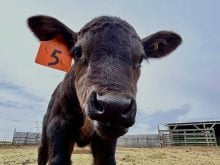I took this photo of a beef cow that had just calved in a drylot holding area. She is in good shape and health so I would expect that once her newborn calf is up on wobbly legs, it will get its first taste of colostrum. Within the next few hours, this new mom will most likely clean and probably join the rest of the herd within the next day. After that, she will get her first taste of a new post-calving diet that will provide a higher plane of nutrition so she can continue to milk well and get ready for the breeding season.
Read Also

Harvest wraps up and fall work begins
At the Eppich famly ranch in western Saskatchewan, the fall harvest was successful with few breakdowns, cows and calves have been sorted and a new tractor has arrived
Keeping a cow in good shape post-partum relies primarily on the dietary maintenance of good body condition of the nursing brood cow. According to the National Research Council (NRC), most post-calving mature cows that maintain an optimum body condition of 2.5-3.0 (1=emaciated and 5=obese) and are nursing newborn calves should be able to consume 35-40 pounds of dry matter feed. This is so they can meet their dietary energy requirements of 60-62 per cent TDN (total digestible nutrients) and 11-12 per cent crude protein when they are milking at their highest levels of 10 to 15 litres per day.
Since first-calf cows do not eat or milk as well as older cows, their dietary requirements are almost identical due to extra nutrients needed for growth. It is also important to remember that all cows, regardless of age, that calve in early February to April may also need 20-30 per cent more dietary energy just to keep warm, added to their most basic maintenance needs and superseding nutrients required for milk production and reproduction.
Essential cattle minerals (and A, D and E vitamins) should also not be forgotten. Calcium, phosphorus and other essential macro-minerals should be provided in all post-partum cow diets. They need to complement whatever mineral levels are found in post-partum forages and other supplemented feeds. In a similar fashion, trace mineral requirements of beef cows nearly double since the start of winter, and good available sources of copper, zinc, manganese, iodine, cobalt, and selenium need to be fed.
Producers describe rations
I conducted a mini-survey of four beef producers who calved-out their cows during the last part of February until the end of March. I asked each about their post-calving feeding programs until the breeding season. Here is what they said:
- Farm #1, 250 beef cows: This producer feeds a traditional overwinter diet of 35-40 lbs. of good-quality alfalfa/grass wrapped hay to his Simmental-cross Black Angus herd. Three to four pounds of barley are supplemented once they calve. Three to four ounces of a 1:1 breeder cattle mineral with salt are fed on the side.
- Farm #2, 300 beef cows: This producer mixes up a TMR which consists of 45 lbs. of barley silage, 18 lbs. of straw, one pound of a 32 per cent protein/TMV supplement with monensin and five pounds of barley. If he finds the cows start to become fleshy, he reduces barley to a couple of pounds.
- Farm #3, 200 beef cows: This producer’s purebred Red Angus brood and first-calf cows came off the hardest part of the winter in good shape. He feeds a TMR of 20 lbs. of barley silage and 25-30 lbs. of alfalfa/grass hay mixed with four ounces of a 3:1 /vitamins premix with monensin. A few pounds of grain are only fed when the windchill temperature dips below -25 C.
- Farm #4, 375 beef cows: All cows and first-calf heifers in this whiteface cross/Simmental herd are fed a TMR of 45 lbs. of drought corn silage with 15 lbs. of grass hay plus a 3:1 mineral/vitamin premix. Grain corn is fed at the rate of three to four pounds per head daily.
All of these nutritious post-calving diets have several characteristics in common: each cow herd had tremendous “as-fed” intakes — upward of 65 lbs. Next, energy and protein requirements were well balanced and last, essential minerals and vitamins were adequately provided. Not to mention that plenty of water was always available. As a result of their similar heightened plane of nutrition during the post-calving period, the general body condition of each of these herds was optimum, so most cows should be well-prepared for the upcoming breeding season.
















